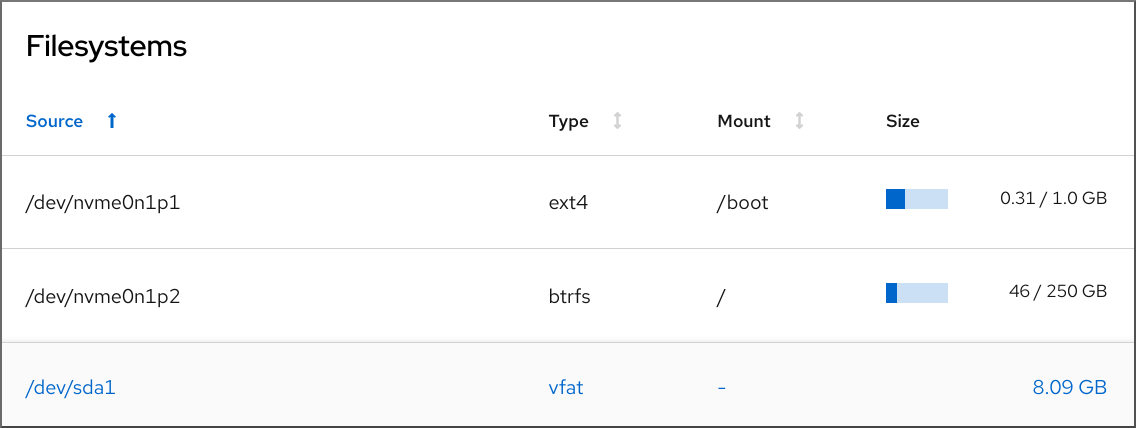Chapter 16. Managing partitions using the web console
Learn how to manage file systems on RHEL 8 using the web console.
For details about the available file systems, see the Overview of available file systems.
16.1. Displaying partitions formatted with file systems in the web console
The Storage section in the web console displays all available file systems in the Filesystems table.
You can to the list of partitions formatted with file systems displayed in the web console.
Prerequisites
-
The
cockpit-storagedpackage is installed on your system. - The web console must be installed and accessible. For details, see Installing the web console.
Procedure
- Log in to the RHEL 8 web console. For details, see Logging in to the web console.
- Click on the Storage tab.
In the Filesystems table, you can see all available partitions formatted with file systems, its name, size and how much space is available on each partition.

16.2. Creating partitions in the web console
To create a new partition:
- Use an existing partition table
- Create a partition
Prerequisites
-
The
cockpit-storagedpackage is installed on your system. - The web console must be installed and accessible. For details, see Installing the web console.
- An unformatted volume connected to the system visible in the Other Devices table of the Storage tab.
Procedure
- Log in to the RHEL web console. For details, see Logging in to the web console.
- Click the Storage tab.
- In the Other Devices table, click a volume in which you want to create the partition.
- In the Content section, click the Create Partition button.
- In the Create partition dialog box, select the size of the new partition.
In the Erase drop down menu, select:
- Do not overwrite existing data — the RHEL web console rewrites only the disk header. Advantage of this option is speed of formatting.
- Overwrite existing data with zeros — the RHEL web console rewrites the whole disk with zeros. This option is slower because the program has to go through the whole disk, but it is more secure. Use this option if the disk includes any data and you need to overwrite it.
In the Type drop down menu, select a file system:
- XFS file system supports large logical volumes, switching physical drives online without outage, and growing an existing file system. Leave this file system selected if you do not have a different strong preference.
ext4 file system supports:
- Logical volumes
- Switching physical drives online without outage
- Growing a file system
- Shrinking a file system
Additional option is to enable encryption of partition done by LUKS (Linux Unified Key Setup), which allows you to encrypt the volume with a passphrase.
- In the Name field, enter the logical volume name.
In the Mounting drop down menu, select Custom.
The Default option does not ensure that the file system will be mounted on the next boot.
- In the Mount Point field, add the mount path.
- Select Mount at boot.
Click the Create Partition button.
Formatting can take several minutes depending on the volume size and which formatting options are selected.
After the formatting has completed successfully, you can see the details of the formatted logical volume on the Filesystem tab.
Verification steps
- To verify that the partition has been successfully added, switch to the Storage tab and check the Filesystems table.
16.3. Deleting partitions in the web console
The following procedure teaches you how to delete partitions in the web console interface.
Prerequisites
-
The
cockpit-storagedpackage is installed on your system. - The web console must be installed and accessible. For details, see Installing the web console.
Unmount the partition’s file system.
For details about mounting and unmounting partitions, see Mounting and unmounting file systems in the web console.
Procedure
- Log in to the RHEL web console. For details, see Logging in to the web console.
- Click on the Storage tab.
- In the Filesystems table, select a volume in which you want to delete the partition.
- In the Content section, click on the partition you want to delete.
The partition rolls down and you can click on the Delete button.
The partition must not be mounted and used.
Verification steps
- To verify that the partition has been successfully removed, switch to the Storage tab and check the Content table.
16.4. Mounting and unmounting file systems in the web console
To be able to use partitions on RHEL systems, you need to mount a file system on the partition as a device.
You also can unmount a file system and the RHEL system will stop using it. Unmounting the file system enables you to delete, remove, or re-format devices.
Prerequisites
-
The
cockpit-storagedpackage is installed on your system. - The web console must be installed and accessible. For details, see Installing the web console.
- If you want to unmount a file system, ensure that the system does not use any file, service, or application stored in the partition.
Procedure
- Log in to the RHEL web console. For details, see Logging in to the web console.
- Click on the Storage tab.
- In the Filesystems table, select a volume in which you want to delete the partition.
- In the Content section, click on the partition whose file system you want to mount or unmount.
Click on the Mount or Unmount button.
At this point, the file system has been mounted or unmounted according to your action.

